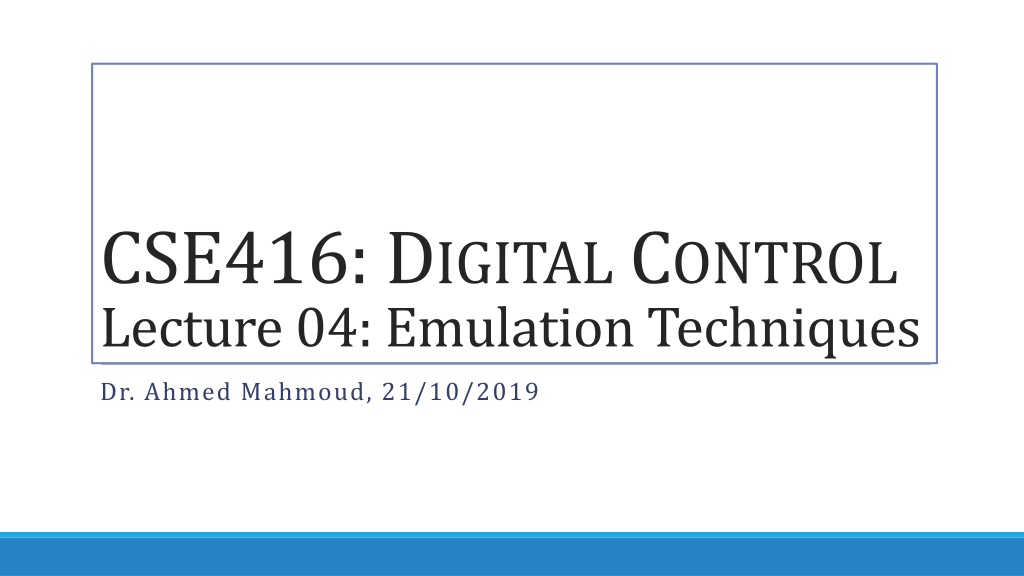
Digital Control Emulation Techniques Lecture Overview
Delve into the world of digital control with a focus on emulation techniques discussed in a CSE416 lecture. Learn about controller emulation, forward Euler approximation, system models, Z-transforms, pole locations, and stability considerations.
Download Presentation

Please find below an Image/Link to download the presentation.
The content on the website is provided AS IS for your information and personal use only. It may not be sold, licensed, or shared on other websites without obtaining consent from the author. If you encounter any issues during the download, it is possible that the publisher has removed the file from their server.
You are allowed to download the files provided on this website for personal or commercial use, subject to the condition that they are used lawfully. All files are the property of their respective owners.
The content on the website is provided AS IS for your information and personal use only. It may not be sold, licensed, or shared on other websites without obtaining consent from the author.
E N D
Presentation Transcript
CSE416: DIGITAL CONTROL Lecture 04: Emulation Techniques Dr. Ahmed Mahmoud, 21/10/2019
Controller Emulation Controller emulation is to use a discrete equivalent of a continuous controller in the design of a digital controller. For a PI controller in continuous-time domain: ? ? ? = ??? ? + ?? ? ? ?? ? The frequency domain representation of the controller is: ? ? = ??+?? ? ? ? For digital realization of such a controller, the proportional part does not pose any problems, however the integrator requires approximation. The integrator can be approximated by Euler s forward rule: ? 1 ? ?? ? ? ?? ?? ? ? ?? ? ?=0 If the sampling period T is sufficiently small, this approximation yields a controller similar to the continuous one. 2 21/10/2019 CSE416: DIGITAL CONTROL
The Drain Tank Example The differential equation model of the system is: ? ? ? = ? ? ? ? The system transfer function is: The unit step response is: ? ? = 1 ? ? ? ? ? 3 21/10/2019 CSE416: DIGITAL CONTROL
Forward Euler Approximation Forward Euler rule approximate derivate by: Approximate the drain tank DE: The approximated difference equation model is: 4 21/10/2019 CSE416: DIGITAL CONTROL
Forward Euler Approximation Behavior ? ?= ?.? ? ?= ?.? ? ?= ? ? ?= ?.? ? ?= ? 5 21/10/2019 CSE416: DIGITAL CONTROL
Z-Transform of Forward Euler The difference equation of the system is: By applying Z transform: ?? ? 1 ? ? ? =? ??(?) ? The transfer function is: ? ? ? =? ?= ? 1 ? ? The discrete equivalent has a pole at ? = 1 ? ? The continuous pole location is fixed at ? = 1 ? 6 21/10/2019 CSE416: DIGITAL CONTROL
Forward Euler Pole Location ? ?= ? ? ?= ?.? ? ?= ? ? ?= ?.? ? ?= ?.? 7 21/10/2019 CSE416: DIGITAL CONTROL
Forward Euler Poles Mapping Forward Euler maps ? ? 1 ? ? 0 ? = ? + ?? 1 1 0 ? 2 -1 ? For achieving stability in discrete-time approximation: 2 ?< 1 ?< 0 ? ?< 2 Accuracy and stability of forward Euler approximation depends on sampling time. 8 21/10/2019 CSE416: DIGITAL CONTROL
Backward Euler Approximation Backward Euler rule approximates derivate by: Approximate the drain tank DE: The approximated difference equation model is: 9 21/10/2019 CSE416: DIGITAL CONTROL
Backward Euler Approximation Behavior ? ?= ?.? ? ?= ?.? ? ?= ? ? ?= ?.? ? ?= ? 10 21/10/2019 CSE416: DIGITAL CONTROL
Z-Transform of Backward Euler The difference equation of the system is: By applying Z transform: 1 +? ? ? ? 1? ? =? ??(?) ? The transfer function is: ? ? ? =? ?= 1 +? ? 1 ? 1 The discrete equivalent has a pole at ? = 1+? ? The continuous pole location is fixed at ? = 1 ? 11 21/10/2019 CSE416: DIGITAL CONTROL
Backward Euler Pole Location ? ?= ?.? ? ?= ? ? ?= ? ? ?= ?.? ? ?= ?.? 12 21/10/2019 CSE416: DIGITAL CONTROL
Backward Euler Poles Mapping Forward Euler maps ? ? 1 ?? ? ? ? = ? ?? 1 0 1 1 2 ? 1 3 2 ? For backward Euler stability, if the continuous pole is stable, then the discrete equivalent pole is also stable. 13 21/10/2019 CSE416: DIGITAL CONTROL
Trapezoidal Rule (Tustin Transformation) The trapezoidal rule uses centered differences to approximate derivatives. Consider the following differential equation: ? ? = ? ? . It has the following transfer function: ? ? ? ?=1 ? . It can be approximated with trapezoidal rule as: ? ? ? ? 1 =? ? +?(? 1) ? 2 The Z transfer function is: ? ? ? ?=? ?+1 2(? 1) . The trapezoidal rule maps ? 2(? 1) ? ?+1 . 14 21/10/2019 CSE416: DIGITAL CONTROL
Which to Use for Implementation? Forward (explicit) Euler approach is numerically not efficient . Complex algorithms designed for efficient numerical integration are not applicable to real-time control systems. Tustin transformation is often used in practice to produce a satisfactory closed-loop system behavior. 15 21/10/2019 CSE416: DIGITAL CONTROL
Example: Emulation of a Lead Controller 1 ?2 is controlled by ? ? = 0.23?+1 Consider a double integrator plant ? ? = which is realized on a digital controller with ? = 1?. Apply Euler s forward transform. ? ? 1 ? ? 0.23 ? 1 + 1 ?+1 ? ? 1 + 1= 0.23? 2 ? ? ? = ? ? ? ? ?? ? = 0.6? 0.4 ? ? . ? ? = 0.6? ? 0.4? ? 1 . 16 21/10/2019 CSE416: DIGITAL CONTROL
Effect of Sampling Time on Control Performance 1 Consider a system: ? 10?+1 . The controller is lead compensator defined as: 10?+1 ?+1 . The controller is sampled fast with ? = 0.05s, and slow with ? = 0.5? 17 21/10/2019 CSE416: DIGITAL CONTROL
